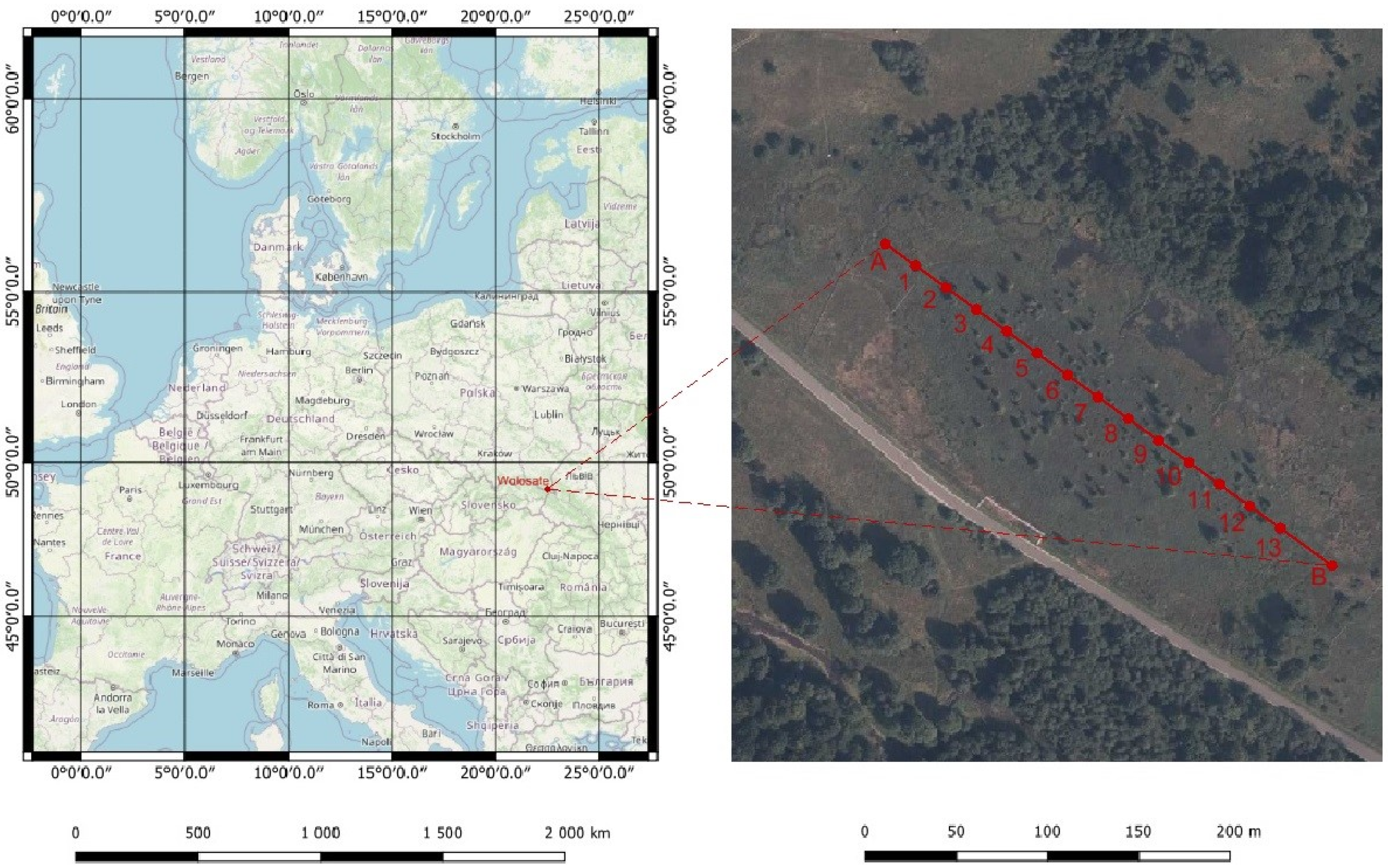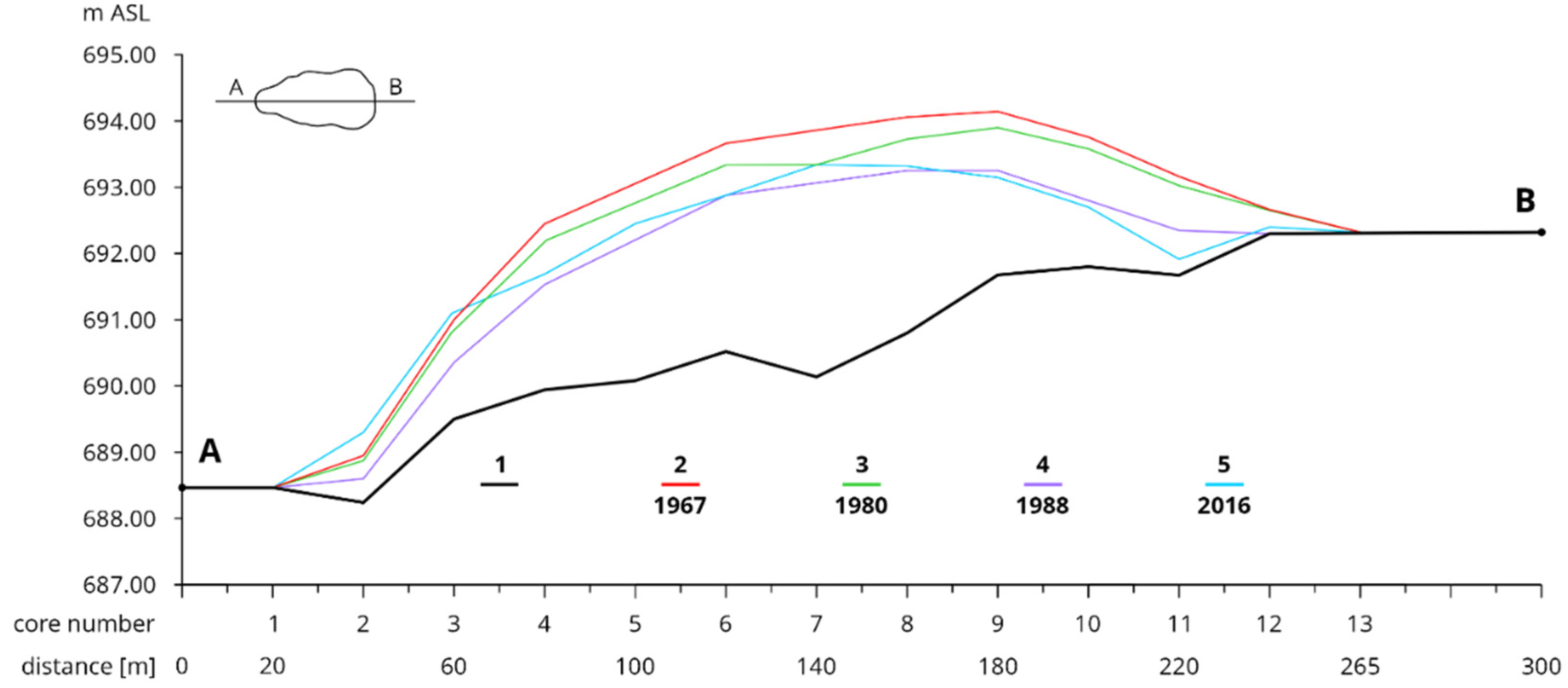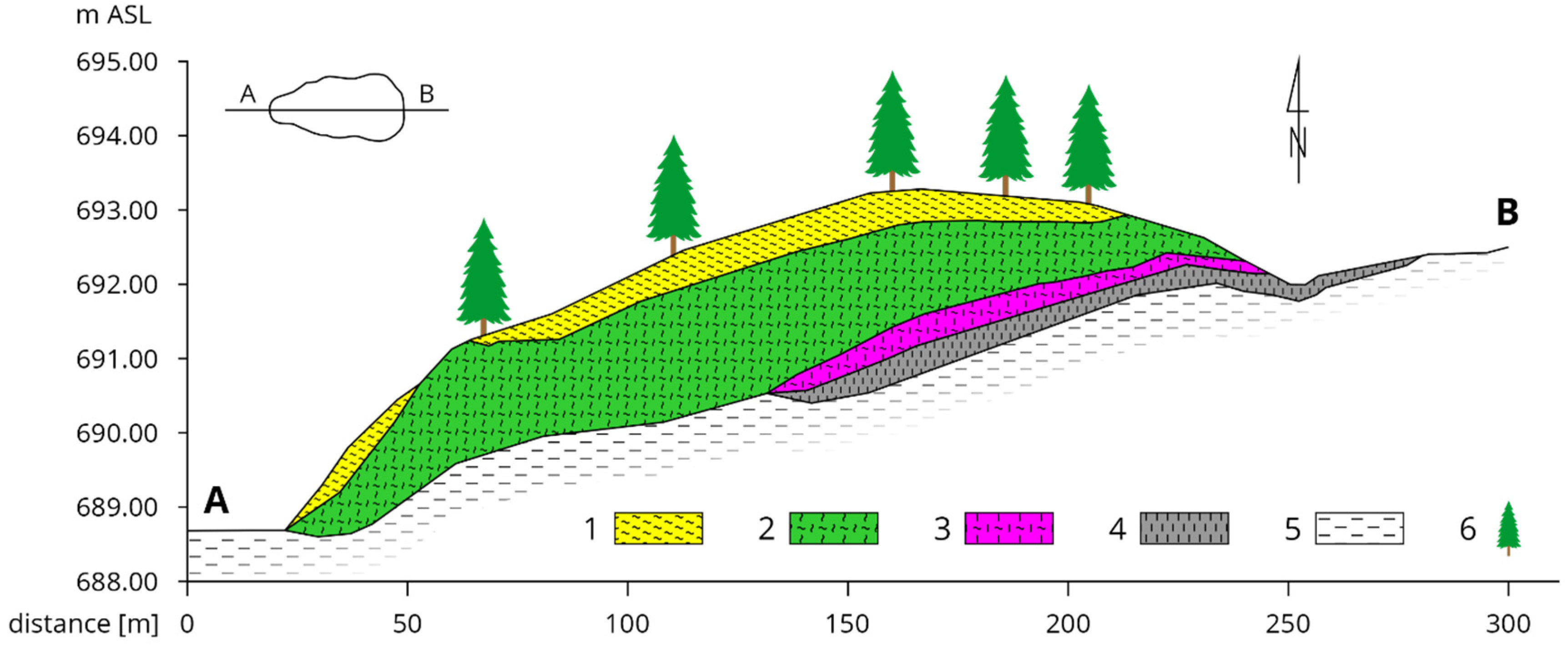Peat Thickness Changes at the “Wołosate” Raised Bog in the Western Bieszczady Mountains
Abstract
1. Introduction
2. Materials and Methods
3. Study Results and Discussion
- ▪
- 1967–1980 the average lowering of the peatland area was −0.9 cm/year,
- ▪
- 1980–1988 the average lowering of the peatland surface was −6.5 cm/year,
- ▪
- 1988–2016, the average increase in the peatland surface by +0.6 cm/year.
4. Conclusions
- The conducted research showed that in the years 1967–2016 (over 49 years), the “Wołosate” bog dome was subject to flattening and deformation. The average thickness of peat deposit in the transect under study decreased by 27.2%, while over a period of 21 years i.e., until 1988, decreased by 34.3%. It can therefore be stated that such significant disappearance was mainly contributed to by the human pressure, as the hydrographic conditions changed radically due to the drainage of the Wołosatka stream valley, which resulted in a disturbance of the peatland’s hydrological system.
- The analysis of changes in the profile of the examined transect shows that during the 28 years, i.e., in the years 1988–2016, in the central and western zones of the bog (drilling points: 8, 7, 5, 4, 3, 2), there was an increase in the acrotelm with the Sphagnum layer from 8 to 78 cm. Thus, the peat thickness in the entirely examined A-B transect increased by an average of 15.5 cm. It can be assumed that this is the effect of restoration treatments carried out in this area by the Bieszczady National Park since 1991.
- On the other hand, a further progressive decrease in thickness of the bog on the eastern side (core points no.: 9, 10, 11) indicates that the so-called closed hydrological system of the raised bog fails to function properly. During the last analyzed period (1988–2016), a further decrease from minus 10 cm to minus 45 cm occurred on that area. A reason for this may be the current natural terrain of Wołosatka river valley (lower topographic gradient from the ponds to the eastern sites). It will be visible after some time whether further restoration measures implemented in this area yield adequate results.
- The stratigraphy of the peat deposit under study shows that almost the entire dome interior is filled with bog peat of the Sphagnum type (Ombro-Sphagnioni), the cottongrass and Sphagnum subtype (Eriophoro-Sphagneti), therefore, the accumulation of organic matter during the peat deposit formation took place in the ombrogenic water environment along with the progressive groundwater level rise and periodic oscillations of its position.
- National parks, landscape parks, nature reserves, and ecological sites are the reflection of striving for a return to nature. Numerous peatlands in the Western Bieszczady Mountains in Poland are still preserved in a near-natural condition. It is therefore essential to implement all restoration measures possible where necessary, in order to protect these unique ecosystems. Future work should include comprehensive floristic, hydrological, and peat-science studies, on peatlands in the Bieszczady Mountains in the restoration aspect. This mainly applies to the “Wołosate” bog as it is the most endangered.
Author Contributions
Funding
Institutional Review Board Statement
Informed Consent Statement
Data Availability Statement
Conflicts of Interest
References
- Poulin, M.; Andersen, R.; Rochefort, L. A new approach for tracking vegetation change after restoration: A case study with peatlands. Restor. Ecol. 2013, 21, 363–371. [Google Scholar] [CrossRef]
- Wilkinson, S.L.; Moore, P.A.; Flannigan, M.D.; Wotton, B.M.; Waddington, J.M. Did enhanced afforestation cause high severity peat burn in the Fort McMurray Horse River wildfire? Environ. Res. Lett. 2018, 13, 014018. [Google Scholar] [CrossRef]
- Loisel, J.; Gallego-Sala, A. Ecological resilience of restored peatlands to climate change. Commun. Earth Environ. 2022, 3, 208. [Google Scholar] [CrossRef]
- Holden, J.; Evans, M.G.; Burt, T.P.; Horton, M. Impact of land drainage on peatland hydrology. J. Environ. Qual. 2006, 35, 1764–1778. [Google Scholar] [CrossRef]
- Koebsch, F.; Gottschalk, P.; Beyer, F.; Wille, C.; Jurasinski, G.; Sachs, T. The impact of occasional drought periods on vegetation spread and greenhouse gas exchange in rewetted fens. Philos. Transac. R. Soc. B 2020, 375, 1367–1377. [Google Scholar] [CrossRef] [PubMed]
- Gallego-Sala, A.V.; Prentice, I.C. Blanket peat biome endangered by climate change. Nat. Clim. Chang. 2013, 3, 152–155. [Google Scholar] [CrossRef]
- Glenk, K.; Faccioli, M.; Martin-Ortega, J.; Schulze, C.; Potts, J. The opportunity cost of delaying climate action: Peatland restoration and resilience to climate change. Glob. Environ. Chang. 2021, 70, 102323. [Google Scholar] [CrossRef]
- Page, S.E.; Baird, A.J. Peatlands and global change: Response and resilience. Annu. Rev. Environ. Resour. 2016, 41, 35–57. [Google Scholar] [CrossRef]
- Tobolski, K. Torfowiska na przykładzie Ziemi Swieckiej [Peatlands, based on the Example of Świecie Land]; Towarzystwo Przyjaciół Dolnej Wisły: Świecie, Poland, 2003; p. 255. [Google Scholar]
- Zając, E. Proces Samoregeneracji Terenów Poeksploatacyjnych na Torfowiskach w Kotlinie Orawsko-Nowotarskiej [The Process of Post-Mining Area Self-Recovery on Peatlands in the Orawa-Nowy Targ Valley]. Ph.D. Thesis, Department of Soil Reclamation and Peatland Protection, University of Agriculture in Kraków, Kraków, Poland, 2003. [Google Scholar]
- Lipka, K.; Zając, E. Hydrological conditions of peatland formation based on a dynamic curve of a biogenic sediment sequence—A new proposal. J. Water Land Dev. 2018, 37, 75–85. [Google Scholar] [CrossRef]
- Lipka, K. Stratigraphy of peatlands in the Western Bieszczady Mountains. Torfoznawstwo w badaniach naukowych i praktyce [Peat science in scientific research and practice]. IMUZ Falenty 1995, 34, 89–102. [Google Scholar]
- Malec, M. Dynamika Wzrostu Torfowisk wysokich w Bieszczadach Zachodnich [The Dynamics of Raised Bog Increase in the Western Bieszczady Mountains]. Ph.D. Thesis, Department of Soil Reclamation and Peatland Protection, University of Agriculture in Kraków, Kraków, Poland, 2006. [Google Scholar]
- Drewnik, M.; Rajwa-Kuligiewicz, A.; Stolarczyk, M.; Kucharczyk, S.; Żelazny, M. Intra-annual groundwater levels and water temperature patterns in raised bogs affected by human impact in mountain areas in Poland. Sci. Total Environ. 2018, 624, 991–1003. [Google Scholar] [CrossRef] [PubMed]
- Lachacz, A.; Nitkiewicz, M.; Kalisz, B. Water repellency of post-boggy soils with a various content of organic matter. Bilogia 2009, 64, 634–638. [Google Scholar] [CrossRef]
- Holden, J.; Chapman, P.J.; Labadz, J.C. Artificial drainage of peatlands: Hydrological and hydrochemical process and wetland restoration. Prog. Phys. Geogr. 2004, 28, 95–123. [Google Scholar] [CrossRef]
- Ketcheson, S.J.; Price, J.S.; Carey, S.K.; Petrone, R.M.; Mendoza, C.A.; Devito, K.J. Constructing fen peatlands in post-mining oil sands landscapes: Challenges and opportunities from a hydrological perspective. Earth-Sci. Rev. 2016, 161, 130–139. [Google Scholar] [CrossRef]
- Ilnicki, P. Regeneracja torfowisk wysokich [Regeneration of raised bogs]. Biul. Inf. „Torf”/Inf. Bull. “Peat” 1967, 4, 13–26. [Google Scholar]
- Ilnicki, P. Torfowiska i Torf [Peatlands and Peat]; Agricultural Academy in Poznań: Poznań, Poland, 2002; p. 606. ISBN 83-7160-243-X. [Google Scholar]
- Ilnicki, P.; Szajdak, L.W. Zanikanie Torfowisk [The Disappearance of Peatlands]; Poznan Society of Friends of Sciences: Poznań, Poland, 2016; p. 312. ISBN 978-83-7654-374-1. [Google Scholar]
- Lipka, K. Zanikanie torfowisk dawno zmeliorowanych w okolicach Rudnika nad Sanem, Leżajska i Przeworska [The disappearance of previously drainaged peatlands in the vicinity of Rudnik nad Sanem, Leżajsk, and Przeworsk]. Rocz. Nauk. Rol./Ann. Agric. Sci. 1978, 79, 95–127. [Google Scholar]
- Lipka, K. Torfowiska w dorzeczu Wisły jako element środowiska przyrodniczego [Peatlands in the Vistula River basin as a component of the natural environment]. Zesz. Nauk. AR W Krakowie/Sci. J. Agric. Univ. Krakow 2000, 255, 148. [Google Scholar]
- Lipka, K.; Zając, E.; Wdowik, W. Wpływ użytkowania na zanikanie gleb torfowo-murszowych w dolinie rzeki Mrowli koło Rzeszowa [The effect of land use on the disappearance of peat and muck soils in the Mrowla River valley n. Rzeszów]. Zesz. Probl. Postępów Nauk. Rol./Adv. Probl. Issues Agric. Sci. 2005, 507, 349–355. (In Polish) [Google Scholar]
- Lipka, K.; Stabryła, J. Wielofunkcyjność Mokradeł w Polsce i Świecie [Multifunctionality of Marshy Grounds in Poland and Worldwide]. In Wybrane Problemy Ochrony Mokradeł [Selected Issues of Marshy Ground Protection]; University of Warmia and Mazury in Olsztyn, Faculty of Environmental Management and Agriculture: Olsztyn, Poland, 2012; pp. 7–16. [Google Scholar]
- Lipka, K.; Zając, E.; Hlotov, V.; Siejka, Z. Disappearance rate of peatland in Dublany near Lviv (Ukraine) drained in 19th century. Mires Peats 2017, 19, 1–15. [Google Scholar]
- Eggelsmann, R.F. Subsidence of Peatland cost by Drainage Evaporation and Oxidation. In Proceedings of the Third International Symposium on Land Subsidence, Venice, Italy, 19–25 March 1984; Johunson, A., Carbognin, L.I., Ubertini, L., Eds.; JAHS Publication No 151. Institute of Hydrology: Oxfordshire, UK, 1986; pp. 497–505. [Google Scholar]
- Okruszko, H. Wyniki wieloletniego doświadczenia dotyczącego wpływu użytkowania na glebę torfową [Results of a multi-annual experiment on the effects of land use on peat soil]. Wiadomości [IMUZ] 1991, 16, 87–107. (In Polish) [Google Scholar]
- Kasimir-Klemedtsson, A.; Klemedtsson, L.; Berglund, K.; Martikainen, P.; Silvola, J.; Oenema, O. Greenhouse gas emissions from farmed organic soils: A review. Sail Use Manag. 1997, 13, 245–250. [Google Scholar] [CrossRef]
- Deverel, S.J.; Ingram, T.; Leighton, D. Present-day oxidative subsidence of organic soils and mitigation in the Sacramento-San Joaquin Delta, California, USA. Hydrogeol. J. 2016, 24, 569–586. [Google Scholar] [CrossRef] [PubMed]
- Waddington, J.; Rochefort, L.; Campeau, S. Sphagnum production and decomposition in a restored cutover peatland. Wetl. Ecol. Manag. 2003, 11, 85–95. [Google Scholar] [CrossRef]
- Hutchinson, J.N. The record of peat wastage in the East Anglian Fenlands at Holme Post, 1848–1978 AD. J. Ecol. 1980, 68, 229–249. [Google Scholar] [CrossRef]
- Glina, B.; Bogacz, A.; Gulyás, M.; Zawieja, B.; Gajeski, P.; Kaczmarek, Z. The effect of long-term forestry drainage on the current state of peatland soils: A case study from Central Sudetes, SW Poland. Mires Peats 2016, 18, 1–11. [Google Scholar] [CrossRef]
- Lisowski, S. Mchy Bieszczadów Zachodnich [Mosses of the Western Bieszczady Mountains]; Polska Akademia Nauk [Polish Academy of Sciences]: Poznań, Poland, 1956; Volume 93. [Google Scholar]
- Skirgiełło, A.; Rudnicka, W. Dokumentacja Geologiczna torfowiska Ustrzyki Górne (Badania Wstępne). [Geological Documentation of the Ustrzyki Górne Bog (Preliminary Research)]; Zakład Systematyki i Geografii Roślin. Uniwersytet Warszawski [Department of Plant Systematics and Geography, University of Warsaw]: Warsaw, Poland, 1960. [Google Scholar]
- Marek, S.; Pałczyński, A. Torfowiska wysokie w Bieszczadach Zachodnich [Raised bogs in the Western Bieszczady Mountains]. Zesz. Probl. Postępów Nauk. Rol./Probl. J. Adv. Agric. Sci. 1962, 34, 253-3. [Google Scholar]
- Lipka, K.; Godziemba-Czyż, W. Torfowiska i młaki potoku Wołosatka w Bieszczadach Zachodnich [Peatlands and flush mires of the Wołosatka stream in the Western Bieszczady Mountains]. Zesz. Nauk. WSR/Sci. J. Agric. Univ. Kraków 1970, 59, 3–23. [Google Scholar]
- Chambers, F.M.; Beilman, D.W.; Yu, Z. Methods for determining peat humification and for quantifying peat bulk density, organic matter and carbon content for palaeostudies of climate and peatland carbon dynamics. Mires Peats 2011, 7, 1–10. [Google Scholar]
- Chimner, R.A.; Pypker, T.G.; Hribljan, J.A.; Moore, P.A.; Waddington, J.M. Multi-decadal Changes in Water Table Levels Alter Peatland Carbon Cycling. Ecosystems 2016, 20, 1042–1057. [Google Scholar] [CrossRef]
- Kucharzyk, S.; Szary, A. Degradacja i ochrona torfowisk wysokich w Bieszczadzkim Parku Narodowym [Degradation and protection of raised bogs in the Bieszczady National Park]. Rocz. Bieszcz./Res. Educ. Cent. Bieszcz. Natl. Park 2012, 20, 83–97. [Google Scholar]
- Skiba, S. Gleby [Soils]. In Plan Ochrony Bieszczadzkiego Parku Narodowego [The Plan of Protection of the Bieszczady National Park]; Monografie Bieszczadzki, Scientific and Educational Centre of the Bieszczady National Park: Ustrzyki Dolne, Poland, 1996; Volume 2. [Google Scholar]
- Zarzycki, K.; Głowaciński, Z. Bieszczady. Przyroda Polska [Bieszczady. Nature Poland]; Wiedza Powszechna [Common Knowledge]: Warsaw, Poland, 1970; p. 193. [Google Scholar]
- Korczagin, A.A. Oprjedjeljenije wozrasta i dlitjelnosti żizni mchow i pjeczjenocznikow [Determination of the increment and life span of mosses and liverworts]. In Poliewaja Giebotanika; Ławrienko, M., Korczagin, A.A., Eds.; The Russian Academy of Sciences, Institute of Botany: Moscow, Russia, 1960. (In Russian) [Google Scholar]
- Malec, M. Aktualny stan szaty roślinnej trzech wybranych torfowisk wysokich w Bieszczadach Zachodnich. [The current state of plant cover in three selected raised bogs in the Western Bieszczady]. Park. Nar. I Rezerw. Przyrody./Natl. Park. Nat. Reserv. 2007, 26, 33–47. [Google Scholar]
- Ralska-Jasiewiczowa, M. The Forests of the Polish Carpathians in the late Glacial and Holocene; Geomorphology Studies Comatho-Balcamica; Committee on Geographical Sciences, Polish Academy of Sciences: Krakow, Poland, 1972; Volume 6. [Google Scholar]
- Ralska-Jasiewiczowa, M. Late-Glacial and Holocene vegetation of the Bieszczady Mts [Polish Eastern Carpathians]; Institute of Botany, Polish Academy of Sciences PWN: Warsaw-Krakow, Poland, 1980; pp. 3–58. [Google Scholar]
- Olechnowicz-Bobrowska, B. Częstość dni z opadem w Polsce [The Frequency of Days with Precipitation in Poland]; Prace geograficzne; Instytut Geografii PAN [PASc Institute of Geography] PWN: Warsaw, Poland, 1970; Volume 86, p. 75. [Google Scholar]
- Instytut Meteorologii i Gospodarki Wodnej; Państwowy Intytut Badawczy; IMGW. Klimat Polski [Polish Climate]; Institute of Meteorology and Water Management; State Research Institute: Warsaw, Poland, 2021. [Google Scholar]
- Borecki, T.; Keczyński, A. Atlas Ubytku Aparatu Asymilacyjnego Drzew Leśnych [Loss of assimilation Apparatus in Forest Trees Atlas]; ATUT: Warsaw, Poland, 1992. [Google Scholar]
- Kraj, W.; Szewczyk, G.; Zarek, M.; Wąsik, R.; Bednarz, B. Radial growth response of Pinus sylvestris L. and Fagus sylvatica L. to technological solutions applied in rope climbing parks. Dendrochronologia 2022, 76, 126000. [Google Scholar] [CrossRef]
- Cherubini, P.; Battipaglia, G.; Innes, J. Tree vitality and forest health: Can tree-ring stable isotopes be used as indicators? Curr. Rep. 2021, 7, 69–80. [Google Scholar] [CrossRef]
- Malec, M. Dynamika wzrostu wybranych torfowisk wysokich w Bieszczadach Zachodnich [Growth dynamics of selected raised bogs in the Western Bieszczady]. Park. Nar. I Rezerw. Przyr. /Natl. Park. Nat. Reserves 2007, 26, 49–64. [Google Scholar]




| Core No | Peat thickness (cm) in Subsequent Years | |||
|---|---|---|---|---|
| 1967 | 1980 | 1988 | 2016 | |
| 1 | 0 | 0 | 0 | 0 |
| 2 | 69 | 62 | 37 | 104 |
| 3 | 150 | 135 | 83 | 161 |
| 4 | 250 | 225 | 159 | 176 |
| 5 | 300 | 270 | 219 | 237 |
| 6 | 315 | 283 | 237 | 236 |
| 7 | 370 | 318 | 289 | 319 |
| 8 | 330 | 297 | 248 | 256 |
| 9 | 250 | 225 | 160 | 150 |
| 10 | 195 | 175 | 88 | 87 |
| 11 | 150 | 135 | 69 | 24 |
| 12 | 40 | 36 | 1 | 10 |
| 13 | 0 | 0 | 0 | 0 |
| Average thickness | 219.9 | 196.5 | 144.5 | 160.0 |
Publisher’s Note: MDPI stays neutral with regard to jurisdictional claims in published maps and institutional affiliations. |
© 2022 by the authors. Licensee MDPI, Basel, Switzerland. This article is an open access article distributed under the terms and conditions of the Creative Commons Attribution (CC BY) license (https://creativecommons.org/licenses/by/4.0/).
Share and Cite
Lipka, K.; Siejka, Z.; Siejka, M. Peat Thickness Changes at the “Wołosate” Raised Bog in the Western Bieszczady Mountains. Water 2022, 14, 3659. https://doi.org/10.3390/w14223659
Lipka K, Siejka Z, Siejka M. Peat Thickness Changes at the “Wołosate” Raised Bog in the Western Bieszczady Mountains. Water. 2022; 14(22):3659. https://doi.org/10.3390/w14223659
Chicago/Turabian StyleLipka, Krzysztof, Zbigniew Siejka, and Monika Siejka. 2022. "Peat Thickness Changes at the “Wołosate” Raised Bog in the Western Bieszczady Mountains" Water 14, no. 22: 3659. https://doi.org/10.3390/w14223659
APA StyleLipka, K., Siejka, Z., & Siejka, M. (2022). Peat Thickness Changes at the “Wołosate” Raised Bog in the Western Bieszczady Mountains. Water, 14(22), 3659. https://doi.org/10.3390/w14223659







